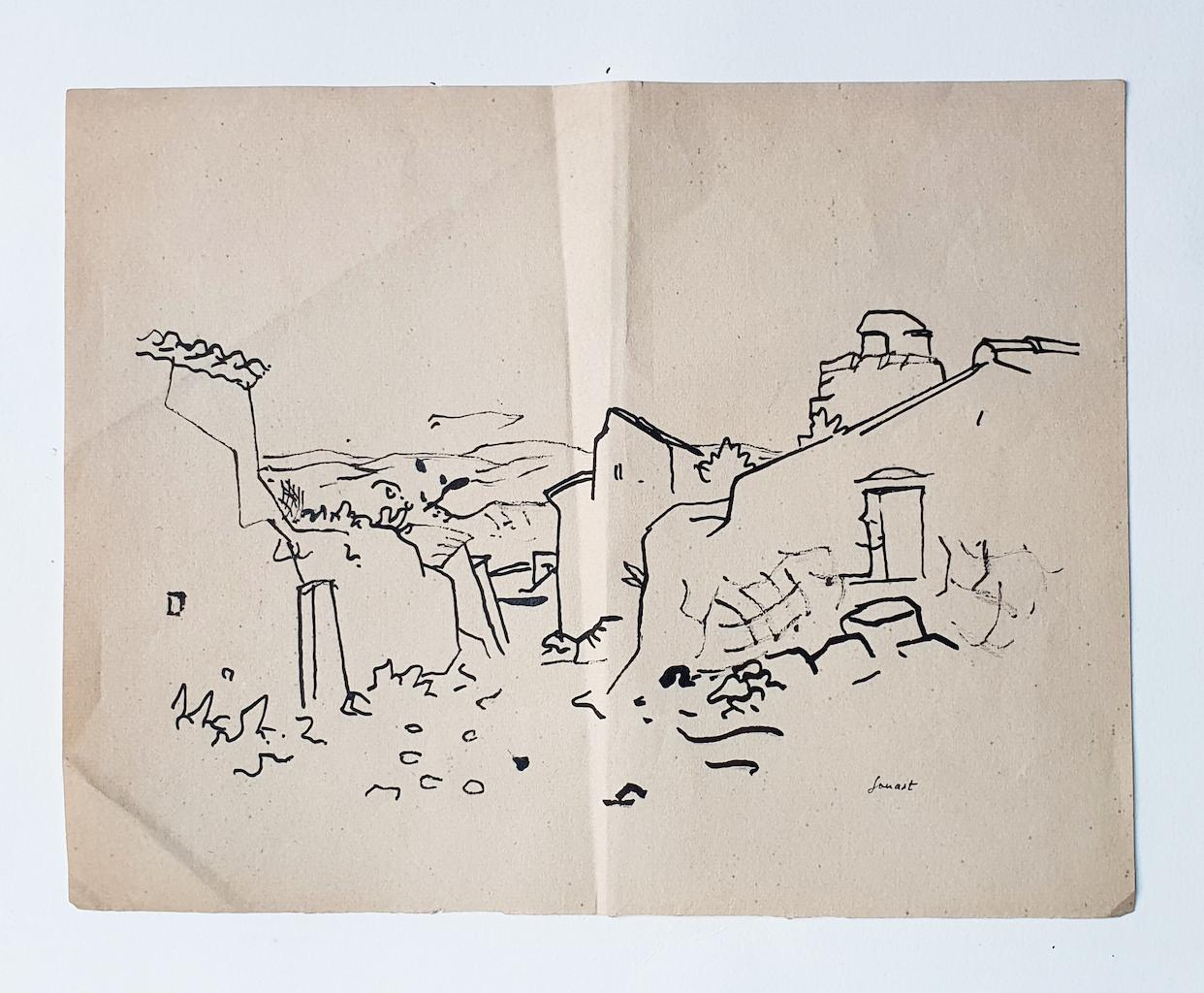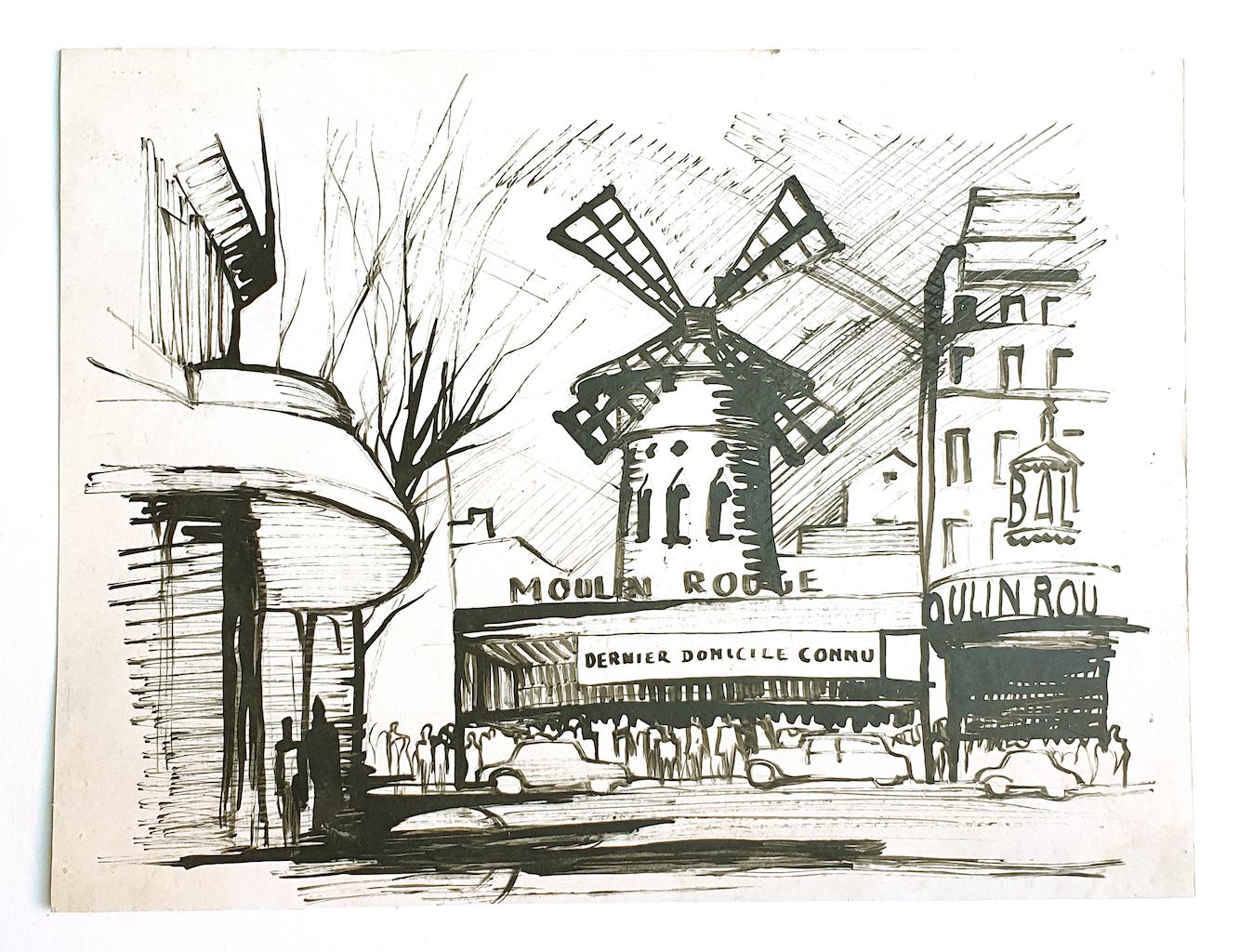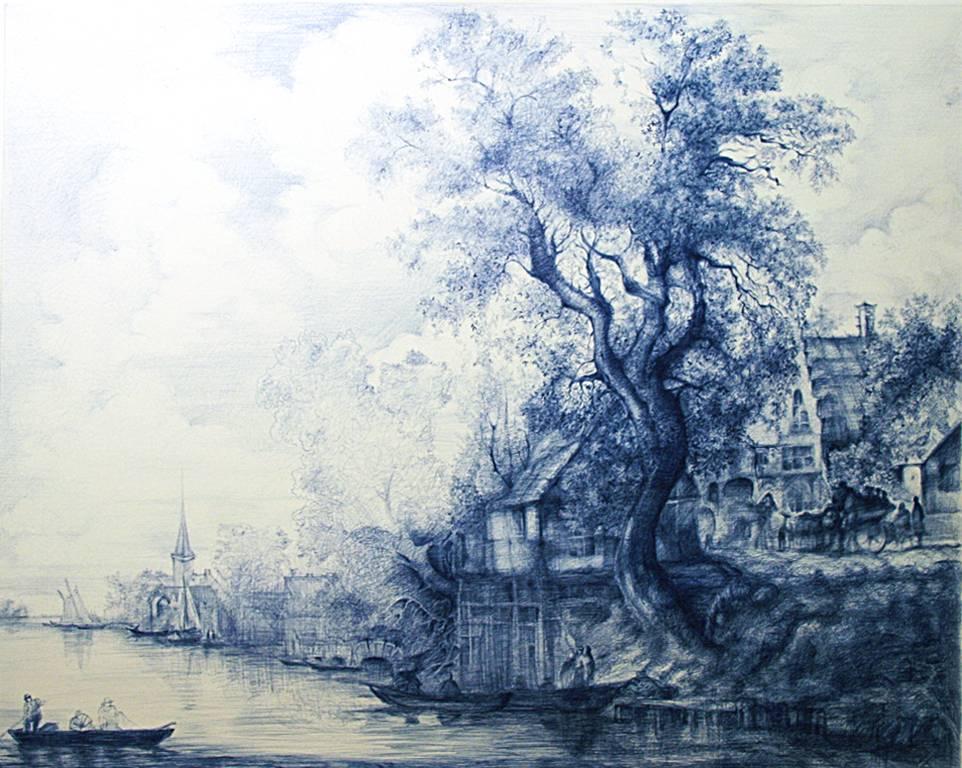Items Similar to Figurative, Drawings, Ink on Paper, Two sided work by Indra Dugar "In Stock"
Want more images or videos?
Request additional images or videos from the seller
1 of 18
Indra DugarFigurative, Drawings, Ink on Paper, Two sided work by Indra Dugar "In Stock"1963-76
1963-76
About the Item
Indra Dugar - Untitled - 8 x 10.5 inches (unframed size) & 16 x 18.5 inches ( framed size )
This is a two sided works, Recto & Verso. Set of 5 art works.
Ink on Paper.
Inclusive of shipment in framed form.
Style : Dugar was known for his paintings of rustic scenes en plein air, painted in a non-academic style, yet retaining colour harmony to reflect the tranquillity of his subject matter. He learnt how to structure his landscapes from Nirode Mazumdar and Rathin Moitra, and from his father, he inherited the tradition of painting on silk. Watercolour and tempera were his preferred media. Dugar's earlier works leaned heavily on his observations, but he gradually began paring down detail.
Dugar soon outgrew the Bengal School mannerisms, invariably visiting places to paint ‘on the spot’ observed views of nature and life. While progressively reducing the naturalistic details in his paintings, Indra Dugar instinctively retained colour harmony for expressing serenity in nature.
About the Artist & his works :
Born : Indra Dugar ( 1918 - 1989 ) was born in Jiagunj, West Bengal.
Education : He was the son of Hira Chand Dugar, a major painter of the early modern period of Indian Art. Indra Dugar, unlike his illustrious father Hirachand Dugar, did not have any formal education in art and during his schooling in Santiniketan he somewhat unconsciously absorbed the artistic ambience of Kala Bhavana and the Neo-Bengal School. Eventually, he outgrew the Bengal School and developed a highly individualistic style of painting.
The technique and art practices he acquired from his father without going through any academic routine. Indra Dugar considered Santiniketan his alma-mater, and drew his inspiration from the art of Nandalal Bose.
Art Career : Perhaps the absence of academic programming gave Dugar’s art a rare individuality that distinguished him from other artists of Kala Bhavana.
Dugar was a versatile artist. He created decorative motifs for the annual sessions of the Congress at Ramgarh, Jaipur and Amritsar, which went beyond his chosen theme of Indian landscapes. He was an art critic with the Bengali publications Desh and Anand Bazar Patrika, and tried his hand at illustrating children's books.Dugar has shown his art as part of several prestigious exhibitions in India and abroad, including an exhibition sponsored by the UNESCO in Paris, in 1946. His art is housed in private and public collections including the Academy of Fine Arts, Indian Museum and Raj Bhavan in Kolkata, and the Japanese Art Association in Tokyo. In 1987, Dugar donated paintings for the Amar Mahal Museum in Jammu.
Award : A member of the Academy of Fine Arts in Kolkata and of the All India Fine Arts and Crafts Society in New Delhi. Dugar soon outgrew the Bengal School mannerisms, invariably visiting places to paint ‘on the spot’ observed views of nature and life. While progressively reducing the naturalistic details in his paintings, Indra Dugar instinctively retained colour harmony for expressing serenity in nature.
- Creator:Indra Dugar (1918 - 1989, Indian)
- Creation Year:1963-76
- Dimensions:Height: 16 in (40.64 cm)Width: 18.5 in (46.99 cm)Depth: 1 in (2.54 cm)
- Medium:
- Movement & Style:
- Period:
- Condition:
- Gallery Location:Kolkata, IN
- Reference Number:1stDibs: LU60434978152
About the Seller
4.9
Vetted Seller
These experienced sellers undergo a comprehensive evaluation by our team of in-house experts.
Established in 2004
1stDibs seller since 2017
118 sales on 1stDibs
Typical response time: 17 hours
- ShippingRetrieving quote...Ships From: Kolkata, India
- Return PolicyA return for this item may be initiated within 7 days of delivery.
More From This SellerView All
- Indian Figurative, Drawing, Ink on Paper, Two sided work by Indra Dugar"In Stock"By Indra DugarLocated in Kolkata, West BengalIndra Dugar - Untitled - 8 x 10.5 inches (unframed size) & 16 x 18.5 inches ( framed size ) This is a two sided works, Recto & Verso. Set of 5 art works. Ink on Paper. Inclusive of shipment in framed form. Style : Dugar was known for his paintings of rustic scenes en plein air, painted in a non-academic style, yet retaining colour harmony to reflect the tranquillity of his subject matter. He learnt how to structure his landscapes from Nirode Mazumdar and Rathin Moitra, and from his father, he inherited the tradition of painting on silk. Watercolour and tempera were his preferred media. Dugar's earlier works leaned heavily on his observations, but he gradually began paring down detail. Dugar soon outgrew the Bengal School...Category
1960s Modern Figurative Drawings and Watercolors
MaterialsPaper, Ballpoint Pen, India Ink, Ink
- Drawings, Figurative, Ink on Paper, Two sided work by Indra Dugar "In Stock"By Indra DugarLocated in Kolkata, West BengalIndra Dugar - Untitled - 8 x 10.5 inches (unframed size) & 16 x 18.5 inches ( framed size ) This is a two sided works, Recto & Verso. Set of 4 art works. Ink on Paper. Inclusive of shipment in framed form. Style : Dugar was known for his paintings of rustic scenes en plein air, painted in a non-academic style, yet retaining colour harmony to reflect the tranquillity of his subject matter. He learnt how to structure his landscapes from Nirode Mazumdar and Rathin Moitra, and from his father, he inherited the tradition of painting on silk. Watercolour and tempera were his preferred media. Dugar's earlier works leaned heavily on his observations, but he gradually began paring down detail. Dugar soon outgrew the Bengal School...Category
1960s Modern Figurative Drawings and Watercolors
MaterialsPaper, Ballpoint Pen, India Ink, Ink
- Being one with Nature II, Man in His Environment, Charcoal Drawing 'In Stock'By Debabrata BasuLocated in Kolkata, West BengalDebabrata Basu - Being one with Nature II - 26 x 20 inches (unframed size) Charcoal on Fabriano Paper Style : Debabrata derives his style and theme by introspecting within himself. ...Category
2010s Contemporary Figurative Drawings and Watercolors
MaterialsCharcoal, Paper
- Baranasi Ghat, lady sitting on the steps of the Tulsighat byBengal School ArtistBy Indra DugarLocated in Kolkata, West BengalIndra Dugar - Baranasi & Tulsi Ghat - 10.5 x 8 inches (unframed size) Ink on paper Inclusive of shipment in roll form. Baranasi Ghat : Exemplary rare drawings by Shri Indra Dugar fr...Category
1960s Modern Figurative Drawings and Watercolors
MaterialsIndia Ink, Ink, Ballpoint Pen, Paper
- Beneras :Steps to the Temple, Inkdrawing, inspired by Bengal Artist NandalalBoseBy Indra DugarLocated in Kolkata, West BengalIndra Dugar - Varanasi Ghat - 10.5 x 8 inches (unframed size) Set of four stunning works, from the notebook of Bengal Maestro artist, Indra Dugar. Ink on paper Inclusive of shipment...Category
1960s Modern Landscape Drawings and Watercolors
MaterialsInk, India Ink, Paper
- Untitled, Pen & Ink on Paper by Modern Indian Artist "In Stock"By Jogen ChowdhuryLocated in Kolkata, West BengalJogen Chowdhury - Untitled - 7.7 x 5.7 inches (unframed size) Pen & Ink on Paper Envelope, 2015 Signed in Bengali Style : He has immense contribution in inspiring young artists of...Category
2010s Modern Still-life Paintings
MaterialsPen, Ink, Paper
You May Also Like
- Landscape - China Ink on Paper by René Gouast - 1950By René GouastLocated in Roma, ITLandscape is an original drawing in China ink on paper realized in 1950 by René Gouast ( 1897-1980). Hand-signed on the lower right. The State of preserva...Category
1950s Modern Figurative Drawings and Watercolors
MaterialsPaper, India Ink
- Moulin Rouge - China Ink on Paper - 20th CenturyLocated in Roma, ITMoulin Rouge is an original drawing in China ink on paper realized by an unknown artist of the XX century. The State of preservation is very goo...Category
20th Century Modern Figurative Drawings and Watercolors
MaterialsPaper, India Ink
- Jan Van Goyen (Baroque Ballpoint pen landscape drawing on paper in Blue ink)By Linda Newman BoughtonLocated in Hudson, NY42 x 54 inches, ballpoint pen on cotton Arches paper 53 x 64 inches framed (brown wood molding, plexi) This drawing is being offered by Carrie Haddad Gallery, located in Hudson, NY The artist's recreation of Dutch landscape painter Jan Van Goyen...Category
2010s Contemporary Landscape Drawings and Watercolors
MaterialsArchival Paper, Pen, Ballpoint Pen
- Thunderstorm Over BostonBy James McBeyLocated in Storrs, CTThunderstorm over Boston. July 14, 1930. Ink and watercolor on paper. 10 5/8 x 17 5/8 (sheet 12 x 19 1/4). Signed and dated and titled in ink, lower right; titled verso and annotated...Category
Mid-20th Century Modern Landscape Drawings and Watercolors
MaterialsIndia Ink, Watercolor
- Rio della Misericordia, Venice.By James McBeyLocated in Storrs, CTRio della Misericordia. October 1924. Watercolor. 14 x 8 3/4. McBey did a striking nocturnal view of the bridge in his 1926 drypoint, The Bridge by Night Carter 232. Signed and dated, lower right; titled verso. Housed in a French mat and a 22 x 16 1/2-inch gold leaf frame. The Rio Della Misericordia ( from the Venetian to the Misericordia Canal ) is a canal from Venice in the sestiere of Cannaregio, Contrada San Marzillan in Italy. The river runs along the old Servite convent. The canal is crossed by two bridges, from east to west: the San Marziale spawning linking the campo of the same name with the Fondamenta de la Misericordia and the dei dei Servi or Betania linking the Mensa di Betania to the Fondamenta de la Misericordia . Born in Newburgh near Aberdeen, James McBey attended evening classes at Graydon's School of Art and taught himself etching, building his own press at the age of fifteen. He moved to London to prepare for a one-man show at Goupil's Gallery, and shortly after this highly successful first show, he traveled to Morocco with James Kerr...Category
Mid-20th Century Modern Landscape Drawings and Watercolors
MaterialsIndia Ink, Watercolor
- Whimsical Fishing Illustration Cartoon 1938 Mt Tremblant Ski Lodge William SteigBy William Steig (b.1907)Located in Surfside, FLLighthearted Illustration of Outdoor Pursuits This one of a fisherman signed "W. Steig" Provenance: from Mrs. Joseph B. Ryan, Commissioned by Joe Ryan for the bar at his ski resort, Mount Tremblant Lodge, in 1938. Mont Tremblant, P.Q., Canada Watercolor and ink on illustration board, sights sizes 8 1/2 x 16 1/2 in., framed. In 1938 Joe Ryan, described as a millionaire from Philadelphia, bushwhacked his way to the summit of Mont Tremblant and was inspired to create a world class ski resort at the site. In 1939 he opened the Mont Tremblant Lodge, which remains part of the Pedestrian Village today. This original illustration is on Whatman Illustration board. the board measures 14 X 22 inches. label from McClees Galleries, Philadelphia, on the frame backing paper. William Steig, 1907 – 2003 was an American cartoonist, sculptor, and, in his later life, an illustrator and writer of children's books. Best known for the picture books Sylvester and the Magic Pebble, Abel's Island, and Doctor De Soto, he was also the creator of Shrek!, which inspired the film series of the same name. He was the U.S. nominee for both of the biennial, international Hans Christian Andersen Awards, as a children's book illustrator in 1982 and a writer in 1988. Steig was born in Brooklyn, New York in 1907, and grew up in the Bronx. His parents were Polish-Jewish immigrants from Austria, both socialists. His father, Joseph Steig, was a house painter, and his mother, Laura Ebel Steig, was a seamstress who encouraged his artistic leanings. As a child, he dabbled in painting and was an avid reader of literature. Among other works, he was said to have been especially fascinated by Pinocchio.He graduated from Townsend Harris High School at 15 but never completed college, though he attended three, spending two years at City College of New York, three years at the National Academy of Design and a mere five days at the Yale School of Fine Arts before dropping out of each. Hailed as the "King of Cartoons" Steig began drawing illustrations and cartoons for The New Yorker in 1930, producing more than 2,600 drawings and 117 covers for the magazine. Steig, later, when he was 61, began writing children's books. In 1968, he wrote his first children's book. He excelled here as well, and his third book, Sylvester and the Magic Pebble (1969), won the Caldecott Medal. He went on to write more than 30 children's books, including the Doctor DeSoto series, and he continued to write into his nineties. Among his other well-known works, the picture book Shrek! (1990) formed the basis for the DreamWorks Animation film Shrek (2001). After the release of Shrek 2 in 2004, Steig became the first sole-creator of an animated movie franchise that went on to generate over $1 billion from theatrical and ancillary markets after only one sequel. Along with Maurice Sendak, Saul Steinberg, Ludwig Bemelmans and Laurent de Brunhofff his is one of those rare cartoonist whose works form part of our collective cultural heritage. In 1984, Steig's film adaptation of Doctor DeSoto directed by Michael Sporn was nominated for the Academy Award for Best Animated Short Film. As one of the most admired cartoonists of all time, Steig spent seven decades drawing for the New Yorker magazine. He touched generations of readers with his tongue–in–cheek pen–and–ink drawings, which often expressed states of mind like shame, embarrassment or anger. Later in life, Steig turned to children's books, working as both a writer and illustrator. Steig's children's books were also wildly popular because of the crazy, complicated language he used—words like lunatic, palsied, sequestration, and cleave. Kids love the sound of those words even if they do not quite understand the meaning. Steig's descriptions were also clever. He once described a beached whale as "breaded with sand." Throughout the course of his career, Steig compiled his cartoons and drawings into books. Some of them were published first in the New Yorker. Others were deemed too dark to be printed there. Most of these collections centered on the cold, dark psychoanalytical truth about relationships. They featured husbands and wives fighting and parents snapping at their kids. His first adult book, Man About Town, was published in 1932, followed by About People, published in 1939, which focused on social outsiders. Sick of Each Other, published in 2000, included a drawing depicting a wife holding her husband at gunpoint, saying, "Say you adore me." According to the Los Angeles Times, fellow New Yorker artist...Category
1930s American Modern Figurative Drawings and Watercolors
MaterialsIndia Ink, Watercolor, Illustration Board
Recently Viewed
View AllMore Ways To Browse
Figurative Work On Paper
Stock Vintage Brown
Japan Ink On Paper
Japanese Ink On Paper
Recto Verso
Japanese Modern Ink Art
Ink On Silk
Ink On Silk Art
Watercolor On Silk
Japanese Arts And Craft Period
India Paper Hand Painted
Japanese Pen And Ink
Retro Japanese Silk Painting
Paintings On Silk India
Vintage Books India
Retro Japanese Painting On Silk
Japanese Pen And Ink Drawings
1969 Pen Set





